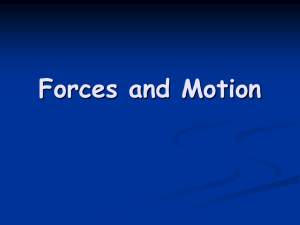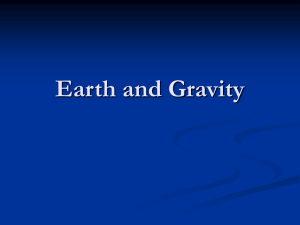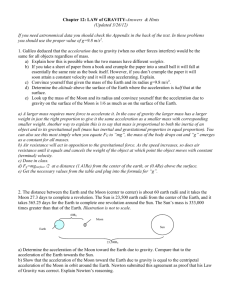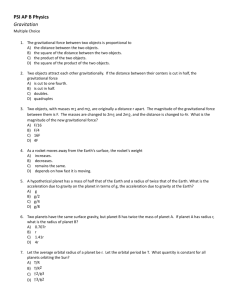Gravity Test
advertisement
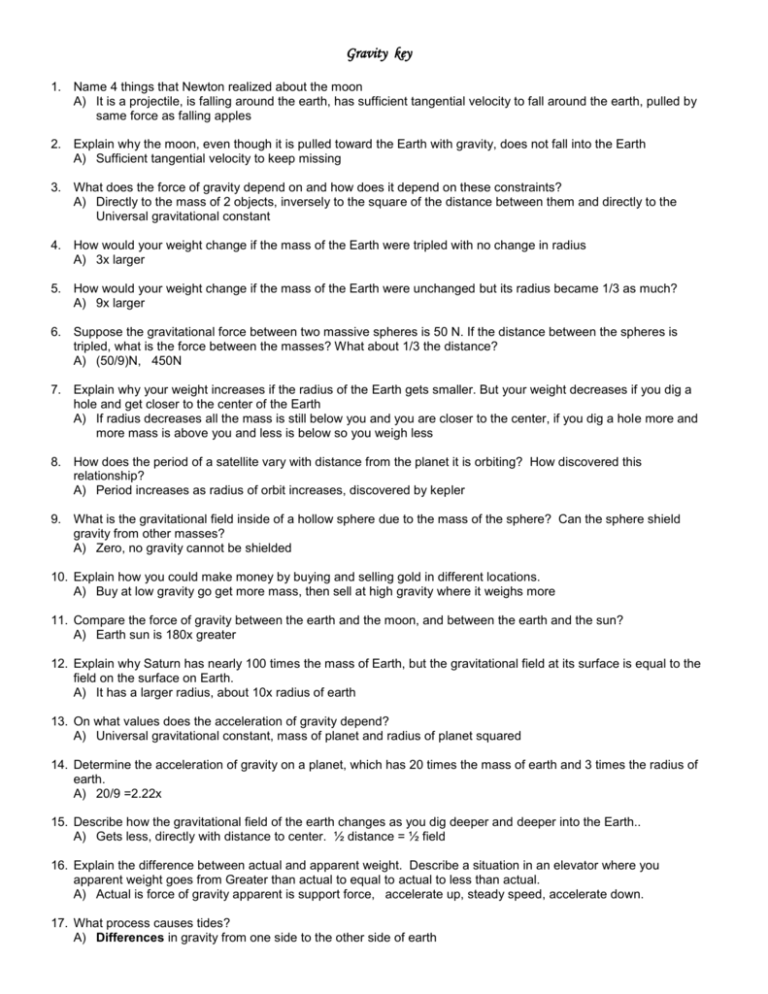
Gravity key 1. Name 4 things that Newton realized about the moon A) It is a projectile, is falling around the earth, has sufficient tangential velocity to fall around the earth, pulled by same force as falling apples 2. Explain why the moon, even though it is pulled toward the Earth with gravity, does not fall into the Earth A) Sufficient tangential velocity to keep missing 3. What does the force of gravity depend on and how does it depend on these constraints? A) Directly to the mass of 2 objects, inversely to the square of the distance between them and directly to the Universal gravitational constant 4. How would your weight change if the mass of the Earth were tripled with no change in radius A) 3x larger 5. How would your weight change if the mass of the Earth were unchanged but its radius became 1/3 as much? A) 9x larger 6. Suppose the gravitational force between two massive spheres is 50 N. If the distance between the spheres is tripled, what is the force between the masses? What about 1/3 the distance? A) (50/9)N, 450N 7. Explain why your weight increases if the radius of the Earth gets smaller. But your weight decreases if you dig a hole and get closer to the center of the Earth A) If radius decreases all the mass is still below you and you are closer to the center, if you dig a hole more and more mass is above you and less is below so you weigh less 8. How does the period of a satellite vary with distance from the planet it is orbiting? How discovered this relationship? A) Period increases as radius of orbit increases, discovered by kepler 9. What is the gravitational field inside of a hollow sphere due to the mass of the sphere? Can the sphere shield gravity from other masses? A) Zero, no gravity cannot be shielded 10. Explain how you could make money by buying and selling gold in different locations. A) Buy at low gravity go get more mass, then sell at high gravity where it weighs more 11. Compare the force of gravity between the earth and the moon, and between the earth and the sun? A) Earth sun is 180x greater 12. Explain why Saturn has nearly 100 times the mass of Earth, but the gravitational field at its surface is equal to the field on the surface on Earth. A) It has a larger radius, about 10x radius of earth 13. On what values does the acceleration of gravity depend? A) Universal gravitational constant, mass of planet and radius of planet squared 14. Determine the acceleration of gravity on a planet, which has 20 times the mass of earth and 3 times the radius of earth. A) 20/9 =2.22x 15. Describe how the gravitational field of the earth changes as you dig deeper and deeper into the Earth.. A) Gets less, directly with distance to center. ½ distance = ½ field 16. Explain the difference between actual and apparent weight. Describe a situation in an elevator where you apparent weight goes from Greater than actual to equal to actual to less than actual. A) Actual is force of gravity apparent is support force, accelerate up, steady speed, accelerate down. 17. What process causes tides? A) Differences in gravity from one side to the other side of earth 18. Explain why the sun pulls harder on the earth than the moon and why the moon causes much greater tides on Earth than the sun does. A) Sun has much more mass so more gravity, moon is closer so difference in gravity from one side to other is greater 19. Describe the alignment necessary for a solar and a lunar eclipse A) Solar, moon in middle: Lunar, Earth is in the middle 20. What is the connection between eclipses and tides A) Higher tides during ecllipses 21. What are the 2 processes that determine the size of a star? A) Gravity pulling in and fusion pushing outward 22. Describe the effect a black hole has on space. A) Alters space very near it due to tremendous density and gravity near the hole. 23. What would happen to the earth if the sun suddenly turned into a black hole with the same mass as the sun. (this actually cannot happen) A) Nothing other than no light from sun 24. The Iron core of a massive star can collapse and form a black hole. What happens to the amount of mass in the core if it does collapse? A) The amount of mass does not change only shrinks in volume 25. By how much does the earth curve down for every 8000 m across? A) 5 m 26. How fast does a satellite that is close to the earth have to travel in order to stay in orbit A) 8 km/s or 8000m/s 27. Describe the speed of satellites in circular and elliptical orbits. An illustration maybe helpful. A) Circular have constant speeds, elliptical orbits are fastest when closest and lowest when furthest away 28. Relate the speed of a satellite to its altitude or height. Who discovered this relationship? A) Slower speed with larger altitude, Kepler 29. Describe how the velocity, radius and magnitude of acceleration vary for a circular and elliptical orbit A) Circular they are constant, elliptical they vary with distance 30. What would a rocket do if it were fired straight up at 11 km/s? If fired at an angle other than straight up? A) Straight up comes straight down (ignoring rotation of earth), at an angle gives an elliptical orbit 31. What primarily determines the speed necessary to orbit a planet? Compare the speeds necessary to orbit the moon, the Earth and Jupiter A) Gravitational field strength, jupiter fastest, moon slowest 32. How can we make a satellite appear to hover above one point on the equator? A) Place at a distance above earth that requires period of 24 hrs 33. What would be the period of a satellite placed 60 earth radiuses (distance to moon) away from the earth? A) Same as the moon, 28 days 34. Does gravity do “work” on all satellites? Explain A) Only in elliptical orbits when force has a component parallel with the veloctiy 35. Describe the changes in energy of a satellite in a circular and elliptical orbit A) No changes for circle, elliptical has constant total, KE is max when close and min when far, PE is opposite 36. What is escape speed? What are the values for the earth and the sun near the earth? A) Speed necessary to escape a planet, 11.2 km/s for earth, 42.2 km/s for sun near earth




